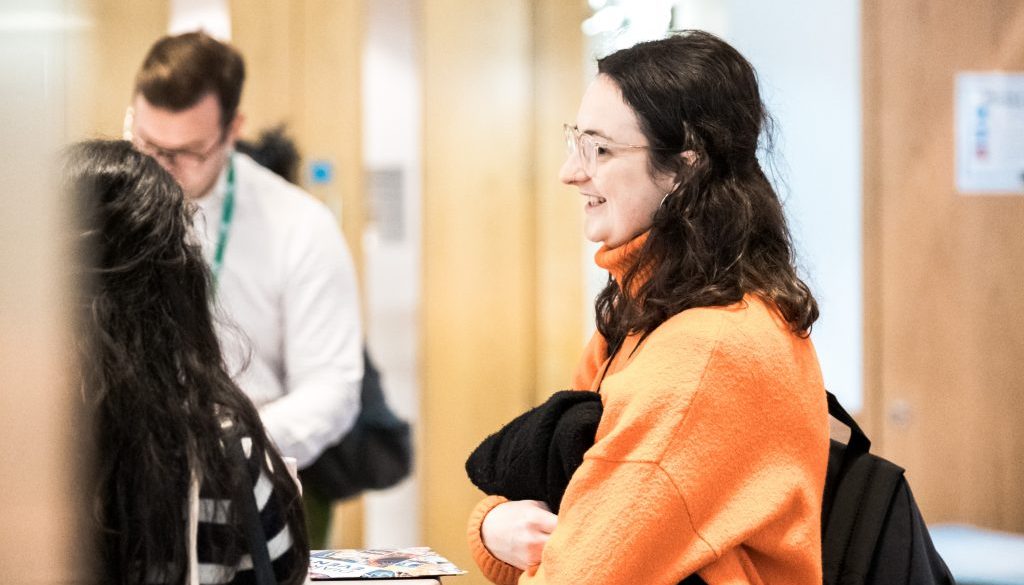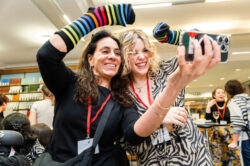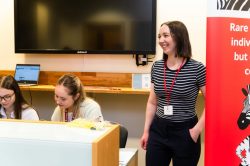A day in the life of a medical student during the pandemic
Written by Chloe Bell, a fourth-year medical student at the University of Manchester
Hi, my name is Chloe and I’m currently a fourth-year medical student at the University of Manchester.
I decided to get in touch with M4RD after thoroughly enjoying a student selected placement in Metabolic Medicine at Salford Royal Hospital last year. I met and learnt from patients with rare metabolic diseases such as PKU, MPS and Gaucher disease, and many other conditions which I had not yet come across in my medical studies. During this placement I focussed on learning about the mental health of patients living with rare diseases. I found that a large proportion of rare disease patients had gone through years of diagnostic tests and investigations, struggling with, not only the mental and physical effects of their illness, but also the emotional burden of searching for a diagnosis. I realised the importance of having an awareness of the rare disease patient experience as a medic and felt compelled to learn more about the specialty.
Following this placement, I attended the M4RD annual symposium in February 2020 where I enjoyed gaining more insight into the rare disease experience of patients with rare disease, their families and the healthcare professionals caring for them.
I wish to work to raise awareness of rare diseases among my medical student peers in the hope that the next generation of doctors will work to know more about rare diseases and how to recognise them. I hope that rare diseases patients of the future will receive the comprehensive and compassionate care they deserve.
In this blog post, I write about my experience as a medical student during the COVID-19 pandemic, giving some insight into what I do and how life in hospitals has changed from the perspective of a medical student. I resumed attending hospital placements in September and continue to attend hospital throughout this second “lockdown”. I feel privileged to be able to learn in a practical way and maintain a steady routine. Especially whilst so many people are having to work and study from home. I also appreciate that many of those shielding may rarely leave the house at all; I didn’t think I’d ever appreciate having to get up early to leave the house every day so much!
I will first talk through a typical day in the life of a medical student and then cover some of the things that have changed in hospital due to the pandemic, before reflecting on my experiences as a medical student.
A typical day as a medical student since the pandemic
9-11am: Morning teaching via Zoom at home. Myself and 10 other medical students on my course were connected via video link to a neurology clinic. The doctor consented the patient first, asking if the patient would be okay if we watched and listened to her consultation. We watched the consultant take a history (an account of symptoms) from the patient and then examine her. We then discussed the case as a group afterwards and the doctor explained his thoughts about what was going on with the patient.
11am-12pm: Online Learning. I had an hour to go through some of my online learning for the week. This week I have been learning about neurological disorders, specifically epilepsy and multiple sclerosis.
12-12:30pm: Drive into Hospital.
12:30-1:30pm: Information Lecture via zoom with the Medical School about COVID-19 related changes to the course.
1:30-2pm: Lunch
2pm: Get changed into my uniform and head to the outpatient clinic.
2pm-5pm: Afternoon sitting in a face-to-face consultant outpatient clinic. When in clinics, I observe the patient and doctor interacting. On this day, I examined the reflexes of two of the clinic patients. After each patient’s appointment, the consultant would discuss the case with me and give feedback on my examining technique.
Pandemic-related changes to placements
One of the smallest but most obvious changes is that everyone wears face masks throughout hospitals. I am much more used to this now after months of wearing one in the supermarket, however it still looks a little strange and masks can be uncomfortable. Whilst this is a simple measure to keep everyone safer from coronavirus, it does make communication more difficult. For many hearing-impaired patients who rely on lip reading, understanding what someone is saying behind a mask is almost impossible. I myself have found it at times difficult to understand conversations when wearing masks, realising I must lip-read much more than I thought! Because of this, non-verbal communication techniques, such as hand gestures, have become much more important.
In addition to the new masks, I also have a new uniform. In my third year I used to wear my own clothes on placement. However, in September my medical school introduced grey uniforms for medical students (pictured below). These are made out of a strong, durable material that can be washed at high temperatures every day in order to clean them thoroughly. Not only are they safer in terms of coronavirus, but they are more comfortable and mean I save time deciding what to wear. The uniform also makes it easier for both healthcare professionals and patients to recognise me as hospital worker. I have found I get asked for directions around the hospital maze much more frequently!
Medical learning
In terms of my medical learning; a lot has changed. Firstly, I spend a lot less time in hospitals and a lot more time at home. Most of my lectures and teaching sessions being held via zoom, and many outpatient clinics are now held over the phone. Usually my role in the hospital is to shadow more experienced doctors, take histories from patients and examine them. Not being able to see as many patients in real life has changed the way I learn. For example, last week I took part in a telephone clinic with a consultant neurologist. I would ring the patient on my mobile phone before their appointment with the doctor to get a bit of background on why they were in clinic that day. One man I spoke to had not seen any of his family since February. We chatted for a while about how he had been coping with this. He spoke to me about keeping up his 10,000 steps every day, getting his own shopping and keeping up to date with the news. Whilst I am still learning about lots of different medical conditions, I am also learning about how individual patients have coped with the emotional impact of the pandemic.
Secondly, the way I will be examined has changed. Usually my practical exams known as Observed Structured Clinical Examinations (OSCEs) involved trained actors and real patients. All the students would rotate around the examination room from patient to patient, moving on when the buzzer went (not unlike speed dating). I would be asked to talk to and examine patients and actors in order to try and work out a diagnosis. This year, because of increased risk of additional people entering hospital sites and social distancing measures, there will be a lot less patient contact involved. For example, I may be asked to examine a mannequin’s eye rather than a human being. Some of my consultations may also be via video link.
Reflections
Although the world has seems like a drastically different place this year, particularly as the second wave is hitting, many things have stayed the same. Whilst studying at medical school, I still get to meet new people every day and learn about patient own stories, be it in real life or via zoom.
Although I may not get as much time in hospital as previous medical students have, studying medicine during the coronavirus pandemic has gained me a new type of knowledge. From simply knowing about different types of PPE and how to don and doff these correctly, to dealing with the stress and anxieties of uncertainty. Whilst the COVID-19 pandemic has brought new challenges to the medical profession, the atmosphere of the hospital remains positive and friendly, many doctors still take time out of their day to teach my peers and me. I feel extremely privileged to be able to continue my studies in these unprecedented times.




